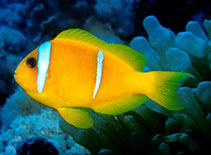| Family: |
Pomacentridae (Damselfishes), subfamily: Pomacentrinae |
| Max. size: |
14 cm TL (male/unsexed) |
| Environment: |
reef-associated; marine; depth range 1 - 30 m, non-migratory |
| Distribution: |
Western Indian Ocean: Red Sea and Chagos Archipelago. |
| Diagnosis: |
Dorsal spines (total): 9-10; Dorsal soft rays (total): 15-17; Anal spines: 2-2; Anal soft rays: 13-14. Yellow orange with 2 black-edged white bands, the first running just behind the head, the second from the notch between the spinous and soft dorsal fin to the abdomen. |
| Biology: |
Adults inhabit lagoons and outer reefs. Oviparous, with elliptical eggs (Ref. 240). Monogamous (Ref. 52884). Oviparous, distinct pairing during breeding (Ref. 205). Eggs are demersal and adhere to the substrate (Ref. 205). Males guard and aerate the eggs (Ref. 205). Associated with the anemones: Entacmaea quadricolor, Heteractis aurora, Heteractis crispa, Heteractis magnifica, and Stichodactyla gigantea (Ref. 5911). Has been reared in captivity (Ref. 35428). |
| IUCN Red List Status: |
Least Concern (LC); Date assessed: 17 November 2010 Ref. (130435)
|
| Threat to humans: |
harmless |
Source and more info: www.fishbase.org. For personal, classroom, and other internal use only. Not for publication.
